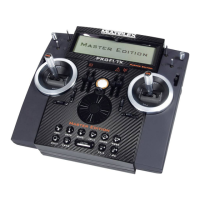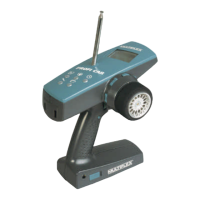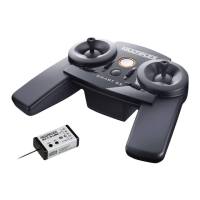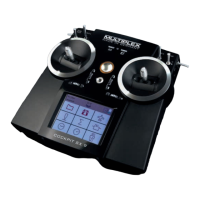UNIVERSAL Helicopter
- 7 -
settings you are defining. In our example we decided
to call the flight mode „
N)
“.
To do this press to open the name field. The first
character in the name should now be flashing.
Use the and buttons to select the character in
the name which you wish to change.
Now use the digi-adjustor to select the character you
wish to enter. We want to call this flight mode „
N)
“.
When you have finished press or to close the
name field again. Pressing the button does not
work in this case because it is used to select the
characters (similar to a cursor key on your PC).
What about the TIME value?“
For the moment we will leave this value unchanged at
zero. The „TIME“ value is used to determine how fast
(or how slow) a transition you require from a different
flight mode to „Hover“. For example, if you set
„02.0sec“ here, then the transition from „AUTO-
ROTATION“ to „Hover“ takes place over a period of
two seconds. The net result is that the new settings
are introduced gradually rather than abruptly.
But now back to assigning:
Switch S-6 selects AUTO-ROTATION
Requirement: the name of the flight mode must not
be flashing (i.e. the field must be closed).
Now press , and „
\
“ will flash. Leaf through with
the button to reach flight mode 5.
Press and change the name (as already described)
to „AUTO-ROTATION“. If that is too laborious, you
can of course shorten it to „AUTO“ or „AUTOROT“.
Now press , and the word „
@LL
“ should flash. Use
the / buttons or the digi-adjustor now to select the
switch S06. The new menu should look like this:
[\iiiIBD@iiiiiiii
////////////////////
iDAZFiiiiiiJGADVN
-.(iiiiiiJ<=]
The arrow „
<
“ after the switch name tells us that auto-
rotation is switched on when the switch toggle is for-
ward (i.e. in the direction of the arrow). The asterisk
„
=
“ following it indicates that the switch is in that state
at this moment.
While the switch name is still flashing you can - if you
wish - change the switch position for auto-rotation
simply by pressing the button. The arrow will now
reverse direction and the asterisk will disappear. The
display „
J0i ]
“ tells you that auto-rotation is now
switched on when the switch toggle is back (towards
you).
IMPORTANT!
The switches you have assigned have no effect
while you are still in this menu. This means that you
can only switch to a different flight mode by pressing
and then leafing through to the desired mode with
the / buttons or the digi-adjustor. Incidentally, this
allows you to check immediately that modes 2, 3 and
4 are „OFF“.
And to continue assigning:
Switch S04 selects DIRECT THROTTLE
Just a reminder: DIRECT THROTTLE means that the
throttle servo is controlled „directly“ by a transmitter
control (i.e. independently of the throttle curve). This is
useful, for example, when you wish to cut the motor.
The COLLECTIVE PITCH stick can then be left at
minimum.
Like the throttle curve, direct throttle is a property of
the COLLECTIVE PITCH transmitter control. To as-
sign a switch to this function we must therefore move
to Menu 1 where the transmitter controls are adjusted.
Starting from the operating screen this is the proce-
dure:
Button Effect and further steps
3 x Call up
Menu 1, Adjust transmitter controls,
and open the Controls field
(transmitter control name flashes)
Select the COLLECTIVE PITCH con-
trol with / or the digi-adjustor
Open the „Options“ field (flashes)
Select the option DIRECT THROTTLE
with / or the digi-adjustor
A quick reminder: the top line in this menu is empty,
which means that the switch assignment for direct
throttle applies to all flight modes.
Now press . The word „
@LL
“ flashes, and you can
select switch S04 using the / buttons or the digi-
adjustor. The menu should then look like this:
V@YDEiXii\V@Q.?ADVNS
[KAE.DNE@D
-J<=
Here again you can reverse the direction of effect of
the switch between „forward“ and „back“ by pressing
the button.
If you wish to proceed immediately with point 5, you
can simply stay in this menu.
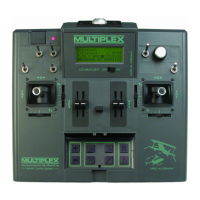
